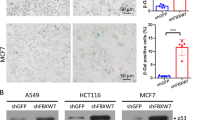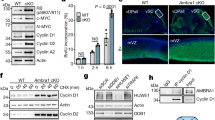Abstract
The F-box protein Fbxw7 (also known as Fbw7, SEL-10, hCdc4 or hAgo) mediates the ubiquitylation and thereby contributes to the degradation of proteins that positively regulate cell cycle. Conditional ablation of Fbxw7 in mouse embryonic fibroblasts (MEFs) induces cell-cycle arrest accompanied by abnormal accumulation of the intracellular domain of Notch1 (NICD1) and c-Myc. However, the molecular mechanisms by which the accumulation of NICD1 and c-Myc induces cell-cycle arrest have remained unclear. We have now examined the expression of cell-cycle inhibitors in Fbxw7-deficient MEFs and found that the abundance of p27Kip1 and p57Kip2 is paradoxically decreased. This phenomenon appears to be attributable to the accumulation of NICD1, given that it was recapitulated by overexpression of NICD1 and blocked by ablation of RBP-J. Conversely, the expression of p16Ink4a and p19ARF was increased in an NICD1-independent manner in Fbxw7-null MEFs. The increased expression of p19ARF was recapitulated by overexpression of c-Myc and abolished by ablation of c-Myc, suggesting that the accumulation of c-Myc is primarily responsible for that of p19ARF. In contrast, the upregulation of p16Ink4a appeared to be independent of c-Myc. These results indicate that cell-cycle inhibitors undergo complex regulation by the Fbxw7-mediated proteolytic system.
This is a preview of subscription content, access via your institution
Access options
Subscribe to this journal
Receive 50 print issues and online access
$259.00 per year
only $5.18 per issue
Buy this article
- Purchase on Springer Link
- Instant access to full article PDF
Prices may be subject to local taxes which are calculated during checkout







Similar content being viewed by others
References
Akhoondi S, Sun D, von der Lehr N, Apostolidou S, Klotz K, Maljukova A et al. (2007). FBXW7/hCDC4 is a general tumor suppressor in human cancer. Cancer Res 67: 9006–9012.
Artavanis-Tsakonas S, Rand MD, Lake RJ . (1999). Notch signaling: cell fate control and signal integration in development. Science 284: 770–776.
Besson A, Hwang HC, Cicero S, Donovan SL, Gurian-West M, Johnson D et al. (2007). Discovery of an oncogenic activity in p27Kip1 that causes stem cell expansion and a multiple tumor phenotype. Genes Dev 21: 1731–1746.
Bonetti P, Davoli T, Sironi C, Amati B, Pelicci PG, Colombo E . (2008). Nucleophosmin and its AML-associated mutant regulate c-Myc turnover through Fbw7γ. J Cell Biol 182: 19–26.
Coats S, Flanagan WM, Nourse J, Roberts JM . (1996). Requirement of p27Kip1 for restriction point control of the fibroblast cell cycle. Science 272: 877–880.
Colombo E, Bonetti P, Lazzerini Denchi E, Martinelli P, Zamponi R, Marine JC et al (2005). Nucleophosmin is required for DNA integrity and p19Arf protein stability. Mol Cell Biol 25: 8874–8886.
Datta A, Nag A, Pan W, Hay N, Gartel AL, Colamonici O et al. (2004). Myc-ARF (alternate reading frame) interaction inhibits the functions of Myc. J Biol Chem 279: 36698–36707.
de Alboran IM, Baena E, Martinez AC . (2004). c-Myc-deficient B lymphocytes are resistant to spontaneous and induced cell death. Cell Death Differ 11: 61–68.
Drayton S, Rowe J, Jones R, Vatcheva R, Cuthbert-Heavens D, Marshall J et al. (2003). Tumor suppressor p16INK4a determines sensitivity of human cells to transformation by cooperating cellular oncogenes. Cancer Cell 4: 301–310.
Georgia S, Soliz R, Li M, Zhang P, Bhushan A . (2006). p57 and Hes1 coordinate cell cycle exit with self-renewal of pancreatic progenitors. Dev Biol 298: 22–31.
Guney I, Wu S, Sedivy JM . (2006). Reduced c-Myc signaling triggers telomere-independent senescence by regulating Bmi-1 and p16INK4a. Proc Natl Acad Sci USA 103: 3645–3650.
Han H, Tanigaki K, Yamamoto N, Kuroda K, Yoshimoto M, Nakahata T et al. (2002). Inducible gene knockout of transcription factor recombination signal binding protein-J reveals its essential role in T versus B lineage decision. Int Immunol 14: 637–645.
Hubbard EJ, Wu G, Kitajewski J, Greenwald I . (1997). sel-10, a negative regulator of lin-12 activity in Caenorhabditis elegans, encodes a member of the CDC4 family of proteins. Genes Dev 11: 3182–3193.
Ishikawa Y, Onoyama I, Nakayama KI, Nakayama K . (2008). Notch-dependent cell cycle arrest and apoptosis in mouse embryonic fibroblasts lacking Fbxw7. Oncogene 27: 6164–6174.
Jia J, Lin M, Zhang L, York JP, Zhang P . (2007). The Notch signaling pathway controls the size of the ocular lens by directly suppressing p57Kip2 expression. Mol Cell Biol 27: 7236–7247.
Kamura T, Hara T, Kotoshiba S, Yada M, Ishida N, Imaki H et al. (2003). Degradation of p57Kip2 mediated by SCFSkp2-dependent ubiquitylation. Proc Natl Acad Sci USA 100: 10231–10236.
Kato H, Sakai T, Tamura K, Minoguchi S, Shirayoshi Y, Hamada Y et al. (1996). Functional conservation of mouse Notch receptor family members. FEBS Lett 395: 221–224.
Kitagawa M, Hatakeyama S, Shirane M, Matsumoto M, Ishida N, Hattori K et al. (1999). An F-box protein, FWD1, mediates ubiquitin-dependent proteolysis of β-catenin. EMBO J 18: 2401–2410.
Knuutila S, Aalto Y, Autio K, Bjorkqvist AM, El-Rifai W, Hemmer S et al. (1999). DNA copy number losses in human neoplasms. Am J Pathol 155: 683–694.
Koepp DM, Schaefer LK, Ye X, Keyomarsi K, Chu C, Harper JW et al. (2001). Phosphorylation-dependent ubiquitination of cyclin E by the SCFFbw7 ubiquitin ligase. Science 294: 173–177.
Li Z, Boone D, Hann SR . (2008). Nucleophosmin interacts directly with c-Myc and controls c-Myc-induced hyperproliferation and transformation. Proc Natl Acad Sci USA 105: 18794–18799.
Lomas J, Martin-Duque P, Pons M, Quintanilla M . (2008). The genetics of malignant melanoma. Front Biosci 13: 5071–5093.
Maitra A, Hruban RH . (2008). Pancreatic cancer. Annu Rev Pathol 3: 157–188.
Mao JH, Perez-Losada J, Wu D, Delrosario R, Tsunematsu R, Nakayama KI et al. (2004). Fbxw7/Cdc4 is a p53-dependent, haploinsufficient tumour suppressor gene. Nature 432: 775–779.
Matsuoka S, Oike Y, Onoyama I, Iwama A, Arai F, Takubo K et al. (2008). Fbxw7 acts as a critical fail-safe against premature loss of hematopoietic stem cells and development of T-ALL. Genes Dev 22: 986–991.
Moberg KH, Bell DW, Wahrer DC, Haber DA, Hariharan IK . (2001). Archipelago regulates Cyclin E levels in Drosophila and is mutated in human cancer cell lines. Nature 413: 311–316.
Morgenstern JP, Land H . (1990). Advanced mammalian gene transfer: high titre retroviral vectors with multiple drug selection markers and a complementary helper-free packaging cell line. Nucleic Acids Res 18: 3587–3596.
Morita S, Kojima T, Kitamura T . (2000). Plat-E: an efficient and stable system for transient packaging of retroviruses. Gene Therapy 7: 1063–1066.
Murata K, Hattori M, Hirai N, Shinozuka Y, Hirata H, Kageyama R et al. (2005). Hes1 directly controls cell proliferation through the transcriptional repression of p27Kip1. Mol Cell Biol 25: 4262–4271.
Nakayama K, Ishida N, Shirane M, Inomata A, Inoue T, Shishido N et al. (1996). Mice lacking p27Kip1 display increased body size, multiple organ hyperplasia, retinal dysplasia, and pituitary tumors. Cell 85: 707–720.
Nakayama KI, Nakayama K . (2006). Ubiquitin ligases: cell-cycle control and cancer. Nat Rev Cancer 6: 369–381.
Nateri AS, Riera-Sans L, Da Costa C, Behrens A . (2004). The ubiquitin ligase SCFFbw7 antagonizes apoptotic JNK signaling. Science 303: 1374–1378.
Onoyama I, Nakayama KI . (2008). Fbxw7 in cell cycle exit and stem cell maintenance: insight from gene-targeted mice. Cell Cycle 7: 3307–3313.
Onoyama I, Tsunematsu R, Matsumoto A, Kimura T, de Alboran IM, Nakayama K et al. (2007). Conditional inactivation of Fbxw7 impairs cell-cycle exit during T cell differentiation and results in lymphomatogenesis. J Exp Med 204: 2875–2888.
Qi Y, Gregory MA, Li Z, Brousal JP, West K, Hann SR . (2004). p19ARF directly and differentially controls the functions of c-Myc independently of p53. Nature 431: 712–717.
Riccio O, van Gijn ME, Bezdek AC, Pellegrinet L, van Es JH, Zimber-Strobl U et al. (2008). Loss of intestinal crypt progenitor cells owing to inactivation of both Notch1 and Notch2 is accompanied by derepression of CDK inhibitors p27Kip1 and p57Kip2. EMBO Rep 9: 377–383.
Sarmento LM, Huang H, Limon A, Gordon W, Fernandes J, Tavares MJ et al (2005). Notch1 modulates timing of G1-S progression by inducing SKP2 transcription and p27Kip1 degradation. J Exp Med 202: 157–168.
Solomon DA, Kim JS, Jean W, Waldman T . (2008). Conspirators in a capital crime: co-deletion of p18INK4c and p16INK4a/p14ARF/p15INK4b in glioblastoma multiforme. Cancer Res 68: 8657–8660.
Strohmaier H, Spruck CH, Kaiser P, Won KA, Sangfelt O, Reed SI . (2001). Human F-box protein hCdc4 targets cyclin E for proteolysis and is mutated in a breast cancer cell line. Nature 413: 316–322.
Sundaram M, Greenwald I . (1993). Suppressors of a lin-12 hypomorph define genes that interact with both lin-12 and glp-1 in Caenorhabditis elegans. Genetics 135: 765–783.
Tetzlaff MT, Yu W, Li M, Zhang P, Finegold M, Mahon K et al. (2004). Defective cardiovascular development and elevated cyclin E and Notch proteins in mice lacking the Fbw7 F-box protein. Proc Natl Acad Sci USA 101: 3338–3345.
Thompson BJ, Jankovic V, Gao J, Buonamici S, Vest A, Lee JM et al. (2008). Control of hematopoietic stem cell quiescence by the E3 ubiquitin ligase Fbw7. J Exp Med 205: 1395–1408.
Tsunematsu R, Nakayama K, Oike Y, Nishiyama M, Ishida N, Hatakeyama S et al. (2004). Mouse Fbw7/Sel-10/Cdc4 is required for notch degradation during vascular development. J Biol Chem 279: 9417–9423.
Urano T, Yashiroda H, Muraoka M, Tanaka K, Hosoi T, Inoue S et al. (1999). p57Kip2 is degraded through the proteasome in osteoblasts stimulated to proliferation by transforming growth factor beta1. J Biol Chem 274: 12197–12200.
Vernon AE, Movassagh M, Horan I, Wise H, Ohnuma S, Philpott A . (2006). Notch targets the Cdk inhibitor Xic1 to regulate differentiation but not the cell cycle in neurons. EMBO Rep 7: 643–648.
Welcker M, Clurman BE . (2008). FBW7 ubiquitin ligase: a tumour suppressor at the crossroads of cell division, growth and differentiation. Nat Rev Cancer 8: 83–93.
Welcker M, Orian A, Grim JE, Eisenman RN, Clurman BE . (2004). A nucleolar isoform of the Fbw7 ubiquitin ligase regulates c-Myc and cell size. Curr Biol 14: 1852–1857.
Yada M, Hatakeyama S, Kamura T, Nishiyama M, Tsunematsu R, Imaki H et al. (2004). Phosphorylation-dependent degradation of c-Myc is mediated by the F-box protein Fbw7. EMBO J 23: 2116–2125.
Zeller KI, Haggerty TJ, Barrett JF, Guo Q, Wonsey DR, Dang CV . (2001). Characterization of nucleophosmin (B23) as a Myc target by scanning chromatin immunoprecipitation. J Biol Chem 276: 48285–48291.
Zindy F, Eischen CM, Randle DH, Kamijo T, Cleveland JL, Sherr CJ et al. (1998). Myc signaling via the ARF tumor suppressor regulates p53-dependent apoptosis and immortalization. Genes Dev 12: 2424–2433.
Acknowledgements
We thank T Honjo for providing RbpjF/F mice; R Tsunematsu for an NICD1 plasmid; T Kitamura for pMX-puro and Plat-E cells; T Senga, Y Ono and N Kobayashi for technical assistance; and N Yanagihara, N Ishida and other laboratory members for helpful discussion and Y Akaida for help in preparation of the paper. This study was supported in part by a Grant-in-Aid and the Network Medicine Global COE Program from the Ministry of Education, Culture, Sports, Science and Technology of Japan.
Author information
Authors and Affiliations
Corresponding author
Rights and permissions
About this article
Cite this article
Masuda, K., Ishikawa, Y., Onoyama, I. et al. Complex regulation of cell-cycle inhibitors by Fbxw7 in mouse embryonic fibroblasts. Oncogene 29, 1798–1809 (2010). https://doi.org/10.1038/onc.2009.469
Received:
Revised:
Accepted:
Published:
Issue Date:
DOI: https://doi.org/10.1038/onc.2009.469
Keywords
This article is cited by
-
FBXW7 inactivation induces cellular senescence via accumulation of p53
Cell Death & Disease (2022)
-
Alteration of FBXW7 is Associated with Worse Survival in Patients Undergoing Resection of Colorectal Liver Metastases
Journal of Gastrointestinal Surgery (2021)
-
Emerging roles of Myc in stem cell biology and novel tumor therapies
Journal of Experimental & Clinical Cancer Research (2018)
-
The deubiquitylase USP37 links REST to the control of p27 stability and cell proliferation
Oncogene (2013)
-
Opposing functions of Fbxw7 in keratinocyte growth, differentiation and skin tumorigenesis mediated through negative regulation of c-Myc and Notch
Oncogene (2013)



